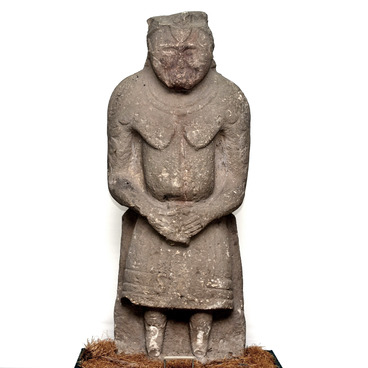The dugout boat was found in the summer of 2001 on the banks of the Desna River, not far from the village of Vschizh. In the 13th century, this place was a city with the same name. The boat lay under a cliff for several centuries, during which time it got almost completely buried under sand and turf. The left side and the stern of the boat have not remained intact.
Dugout Boat
Creation period
13th century
Dimensions
880x125 cm
Technique
Wood, chiseling, burning, manual processing
Collection
Exhibition
6
Open in app#1
Dugout Boat
#2
#3
In ancient times, dugout boats were made of solid trunks whose length reached 20 meters and width, 3 meters. The core of the trunk was hollowed out, and the sides were burned from the inside. Then, the future boat was filled with water and hot rocks were thrown inside it. When the wood got steamed under the influence of heat and moisture, the sides were forced apart by cross struts so that the future ship would be wider.
For durability, wooden ribs were inserted inside the hull and fastened by nails. This preserved the boat’s sides from collapse. Due to this, the shape of the vessel varied: at the bow and stern, the outline of the tree trunk was preserved and the sides were slightly bent inward, then rose almost vertically. At the center of the boat, the sides were bent outward.
#9
Dugout Boat
#4
The surviving part of the Vschizh boat was 8.8 meters long and 1.25 meters wide. It was made from an oak trunk. The inside was reinforced with bent frames. Several oak guard nails have remained in its board, driven in at equal distances from each other. They were used to check the thickness of the sides during the hollowing out procedure: it had to be the same along the entire length of the vessel.
#5
Researchers found several holes of various shapes and sizes in the boat’s hull. Some of them are filed in a row under the edge of the side: probably, this is where oarlocks were attached. Judging by the number of those orifices, the boat was driven by six pairs of rowers. Six more round holes were found in the bow. According to different versions, they could be used either as oarlocks for the steering oar or as extensions for the mast.
#6
Closer to the ends of the boat, the bottom narrowed slightly and rose. The stern was probably the same shape as the bow, and the steering oar could be mounted on either end. Such design made it possible not to turn the ship around: because of its vast length, it was dangerous to expose its sides to current. The dugout boat could fit up to 16 people, including rowers, helmsman and lookout man. The boat was fast and could carry heavy loads. Researchers have suggested that in ancient times it was used for commercial or military purposes.
#8
Dugout Boat
#7
Before the boat got into the permanent exhibition of the Bryansk State Local Lore Museum, it had been dried for several months, after which the junction of the fragments was strengthened with wooden pins and treated with protective compound.
#10
State budgetary cultural institution Bryansk State Regional Ethnography Museum
read morehide
00:00
00:00
1x
Dugout Boat
Creation period
13th century
Dimensions
880x125 cm
Technique
Wood, chiseling, burning, manual processing
Collection
Exhibition
6
Open in app
Share
